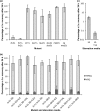Cytocidal amino acid starvation of Saccharomyces cerevisiae and Candida albicans acetolactate synthase (ilv2{Delta}) mutants is influenced by the carbon source and rapamycin
- PMID: 20019084
- PMCID: PMC2841795
- DOI: 10.1099/mic.0.034348-0
Cytocidal amino acid starvation of Saccharomyces cerevisiae and Candida albicans acetolactate synthase (ilv2{Delta}) mutants is influenced by the carbon source and rapamycin
Abstract
The isoleucine and valine biosynthetic enzyme acetolactate synthase (Ilv2p) is an attractive antifungal drug target, since the isoleucine and valine biosynthetic pathway is not present in mammals, Saccharomyces cerevisiae ilv2Delta mutants do not survive in vivo, Cryptococcus neoformans ilv2 mutants are avirulent, and both S. cerevisiae and Cr. neoformans ilv2 mutants die upon isoleucine and valine starvation. To further explore the potential of Ilv2p as an antifungal drug target, we disrupted Candida albicans ILV2, and demonstrated that Ca. albicans ilv2Delta mutants were significantly attenuated in virulence, and were also profoundly starvation-cidal, with a greater than 100-fold reduction in viability after only 4 h of isoleucine and valine starvation. As fungicidal starvation would be advantageous for drug design, we explored the basis of the starvation-cidal phenotype in both S. cerevisiae and Ca. albicans ilv2Delta mutants. Since the mutation of ILV1, required for the first step of isoleucine biosynthesis, did not suppress the ilv2Delta starvation-cidal defects in either species, the cidal phenotype was not due to alpha-ketobutyrate accumulation. We found that starvation for isoleucine alone was more deleterious in Ca. albicans than in S. cerevisiae, and starvation for valine was more deleterious than for isoleucine in both species. Interestingly, while the target of rapamycin (TOR) pathway inhibitor rapamycin further reduced S. cerevisiae ilv2Delta starvation viability, it increased Ca. albicans ilv1Delta and ilv2Delta viability. Furthermore, the recovery from starvation was dependent on the carbon source present during recovery for S. cerevisiae ilv2Delta mutants, reminiscent of isoleucine and valine starvation inducing a viable but non-culturable-like state in this species, while Ca. albicans ilv1Delta and ilv2 Delta viability was influenced by the carbon source present during starvation, supporting a role for glucose wasting in the Ca. albicans cidal phenotype.
Figures





Similar articles
-
Cryptococcus neoformans Ilv2p confers resistance to sulfometuron methyl and is required for survival at 37 degrees C and in vivo.Microbiology (Reading). 2004 May;150(Pt 5):1547-1558. doi: 10.1099/mic.0.26928-0. Microbiology (Reading). 2004. PMID: 15133116
-
Fungal homoserine kinase (thr1Delta) mutants are attenuated in virulence and die rapidly upon threonine starvation and serum incubation.Eukaryot Cell. 2010 May;9(5):729-37. doi: 10.1128/EC.00045-10. Epub 2010 Mar 19. Eukaryot Cell. 2010. PMID: 20305003 Free PMC article.
-
Towards diacetyl-less brewers' yeast. Influence of ilv2 and ilv5 mutations.J Basic Microbiol. 1988;28(3):175-83. doi: 10.1002/jobm.3620280304. J Basic Microbiol. 1988. PMID: 3057172
-
Rapamycin and less immunosuppressive analogs are toxic to Candida albicans and Cryptococcus neoformans via FKBP12-dependent inhibition of TOR.Antimicrob Agents Chemother. 2001 Nov;45(11):3162-70. doi: 10.1128/AAC.45.11.3162-3170.2001. Antimicrob Agents Chemother. 2001. PMID: 11600372 Free PMC article.
-
Generating anchors only to lose them: The unusual story of glycosylphosphatidylinositol anchor biosynthesis and remodeling in yeast and fungi.IUBMB Life. 2018 May;70(5):355-383. doi: 10.1002/iub.1734. IUBMB Life. 2018. PMID: 29679465 Review.
Cited by
-
The SPS amino acid sensor mediates nutrient acquisition and immune evasion in Candida albicans.Cell Microbiol. 2016 Nov;18(11):1611-1624. doi: 10.1111/cmi.12600. Epub 2016 May 27. Cell Microbiol. 2016. PMID: 27060451 Free PMC article.
-
Harzianic Acid from Trichoderma afroharzianum Is a Natural Product Inhibitor of Acetohydroxyacid Synthase.J Am Chem Soc. 2021 Jun 16:10.1021/jacs.1c03988. doi: 10.1021/jacs.1c03988. Online ahead of print. J Am Chem Soc. 2021. PMID: 34132537 Free PMC article.
-
Inhibitors of amino acids biosynthesis as antifungal agents.Amino Acids. 2015 Feb;47(2):227-49. doi: 10.1007/s00726-014-1873-1. Epub 2014 Nov 20. Amino Acids. 2015. PMID: 25408465 Free PMC article. Review.
-
Fungal L-Methionine Biosynthesis Pathway Enzymes and Their Applications in Various Scientific and Commercial Fields.Biomolecules. 2024 Oct 17;14(10):1315. doi: 10.3390/biom14101315. Biomolecules. 2024. PMID: 39456248 Free PMC article. Review.
-
A Limited Number of Amino Acid Permeases Are Crucial for Cryptococcus neoformans Survival and Virulence.Int J Microbiol. 2024 Aug 8;2024:5566438. doi: 10.1155/2024/5566438. eCollection 2024. Int J Microbiol. 2024. PMID: 39148675 Free PMC article. Review.
References
-
- Bulder, C. J. (1964). Induction of petite mutation and inhibition of synthesis of respiratory enzymes in various yeasts. Antonie Van Leeuwenhoek 30, 1–9. - PubMed
-
- Chipman, D., Barak, Z. & Schloss, J. V. (1998). Biosynthesis of 2-aceto-2-hydroxy acids: acetolactate synthases and acetohydroxyacid synthases. Biochim Biophys Acta 1385, 401–419. - PubMed
Publication types
MeSH terms
Substances
Grants and funding
LinkOut - more resources
Full Text Sources
Other Literature Sources
Molecular Biology Databases
Research Materials

